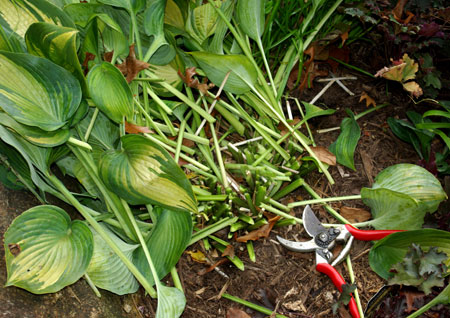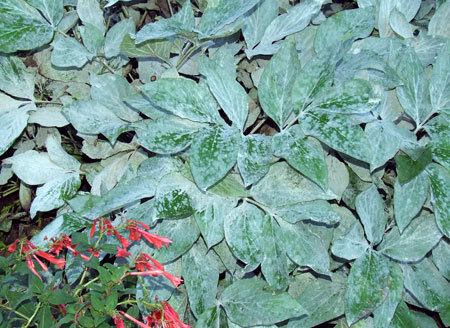Fall perennial care – less is more
Investing time this fall to remove debris from the perennial garden will reap benefits next spring.
Gardening experts tend to disagree on the level of fall care that should occur in a perennial garden. I can say from experience that there are many “creative” ways to dismantle a garden that both reveal its winter beauty and encourage a winter haven for birds and pollinators. Perennials can certainly go into winter without being cut back at all. Some perennials and grasses are very ornamental throughout the bleak seasons and can also be a source of food for birds.

Cutting back perennials will remove hiding places for slugs and
voles. Photo credit: Rebecca Finneran, MSU Extension
The concept behind clearing out debris from a perennial garden is rooted in the integrated pest management (IPM) philosophy known as sanitation. Michigan State University Extension recommends removing leaves, petioles and stems of plants such as Hosta, daylily and peony, which can reduce levels of disease inoculum and eggs of insects or slugs. The following spring, plants have a “clean slate” to grow with reduced likeliness of infestation from these same pests which will lead to reduced need for pesticide controls.

Diseased foliage, such as this peony, should be removed from
the garden to reduce inoculum for the next season.
Photo credit: Rebecca Finneran, MSU Extension
Untrimmed perennial beds also become a haven for blowing fall leaves. The leaves tend to cluster over the crowns of perennials, making a comfy cover for mice and voles. If the garden has a history of this type of damage, removing leaf litter and cakes of mulch that piled up over summer will remove hiding places near the vulnerable crowns of plants such as balloon flower, lilies and Hostas. Natural predators of rodents are more likely to locate them if the garden bed is no longer providing refuge.
Allowing blowing leaves to pile up in a garden also encourages perennial crowns to begin sprouting very early in the spring. This tender tissue may be easily damaged by spring raking or even hand-cleaning of the matted leaves.
Whichever way you plan to “put the garden to bed for winter,” perennial residues should be cut back when the snow melts—the sooner, the better. Grasses, especially, benefit from being trimmed back as close to the ground as possible – usually in late March before their crowns begin to emerge as the soil warms.
For more information on a wide variety of garden topics, visit www.migarden.msu.edu or contact MSU’s toll-free garden hotline at 1-888-678-3464 with any of your questions.



 Print
Print Email
Email
